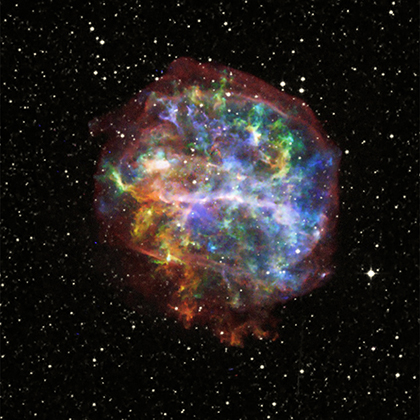For Release: October 23, 2007
CXC Release
A spectacular new image shows how complex a star's afterlife can be. By studying the details of this image made from a long observation by NASA's Chandra X-ray Observatory, astronomers can better understand how some stars die and disperse elements like oxygen into the next generation of stars and planets.
At a distance of about 20,000 light years, G292.0+1.8 is one of only three supernova remnants in the Milky Way known to contain large amounts of oxygen. The image shows a rapidly expanding, intricately structured, debris field that contains, along with oxygen, other elements such as neon and silicon that were forged in the star before it exploded.
"We are finding that, just like snowflakes, each supernova remnant is complicated and beautiful in its own way," said Sangwook Park of Penn State who led the work, released in conjunction with the "8 Years of Chandra" symposium in Huntsville, Ala.
The new, deep Chandra image - equaling nearly 6 days worth of observing time - shows an incredibly complex structure. Understanding the details of G292.0+1.8 is especially important because astronomers have considered it to be a "textbook" case of a supernova created by the death of a massive star.
By mapping the distribution of X-rays in different energy bands, the Chandra image traces the distribution of chemical elements ejected in the supernova. The results imply that the explosion was not symmetrical. For example, blue (silicon and sulfur) and green (magnesium) are seen strongly in the upper right, while yellow and orange (oxygen) dominate the lower left. These elements light up at different temperatures, indicating that the temperature is higher in the upper right portion of G292.0+1.8.
Slightly below and to the left of the center of G292.0+1.8 is a pulsar, a dense, rapidly rotating neutron star that remained behind after the original star exploded. Assuming that the pulsar was born at the center of the remnant, it is thought that recoil from the lopsided explosion may have kicked the pulsar in this direction.
Surrounding the pulsar is a so-called pulsar wind nebula, a magnetized bubble of high-energy particles. The narrow, jet-like feature running from north to south in the image is likely parallel to the spin axis of the pulsar. This structure is most easily seen in high energy X-rays. In the case of G292.0+1.8, the spin direction and the kick direction do not appear to be aligned, in contrast to apparent spin-kick alignments in some other supernova remnants.
Another intriguing feature of this remnant is the bright equatorial belt of X-ray emission that extends across the center of the remnant. This structure is thought to have been created when the star - before it died - expelled material from around its equator via winds. The orientation of the equatorial belt suggests that the parent star maintained the same spin axis both before and after it exploded.
"The detection of the pulsar and its wind nebula confirms that the supernova that led to G292 produced a neutron star through the collapse of the core of a massive star," said coauthor John Hughes of Rutgers University, "The ability to study the asymmetry of the original explosion using X-ray images of the remnant gives us a powerful new technique for learning about these cataclysmic events."
These results will appear in an upcoming issue of The Astrophysical Journal Letters. NASA's Marshall Space Flight Center, Huntsville, Ala., manages the Chandra program for the agency's Science Mission Directorate. The Smithsonian Astrophysical Observatory controls science and flight operations from the Chandra X-ray Center in Cambridge, Mass.
http://chandra.harvard.edu
and
http://chandra.nasa.gov
MEDIA CONTACTS
Jennifer Morcone
Marshall Space Flight Center, Huntsville, Ala.
(Phone: 256/544-7199)
Megan Watzke
Chandra X-ray Center, Cambridge, Mass.
(Phone: 617/496-7998)







